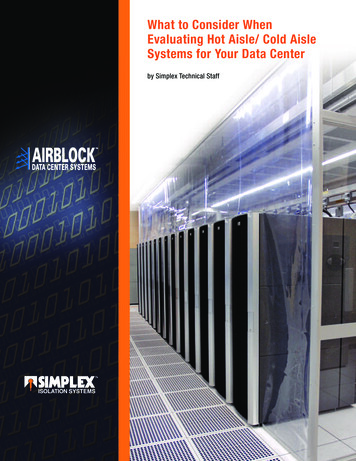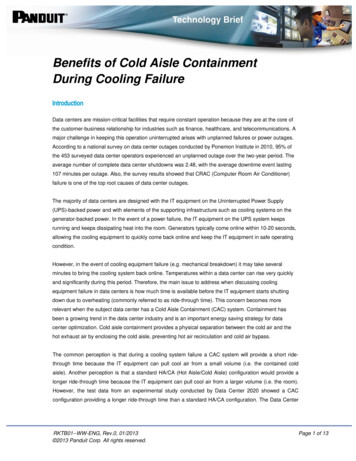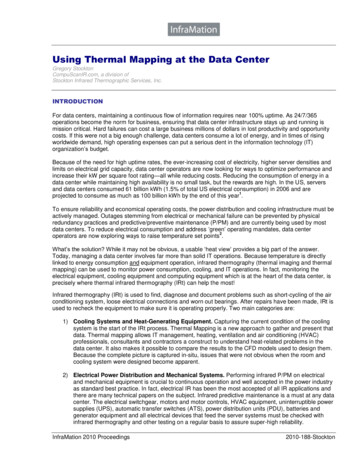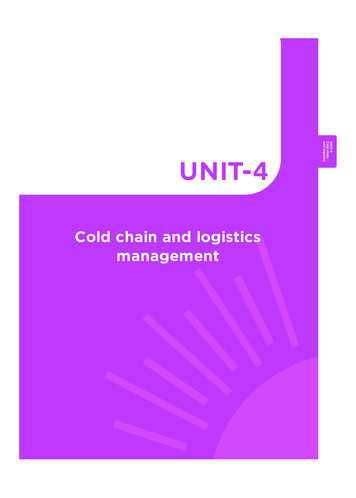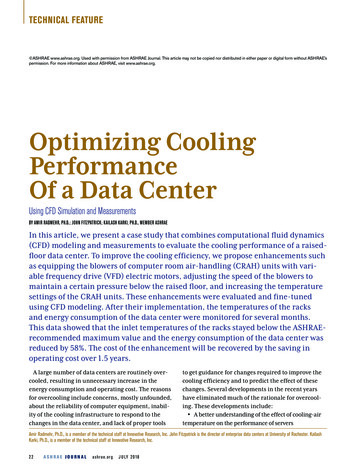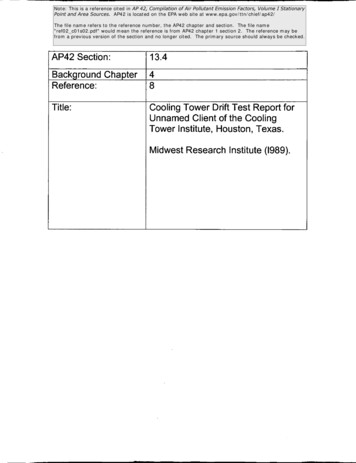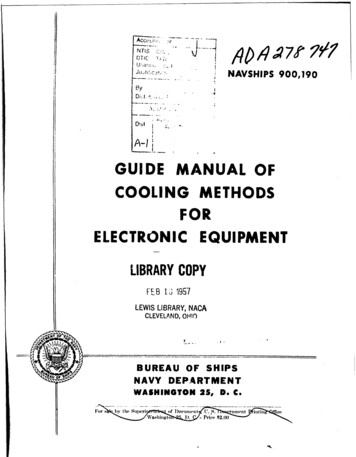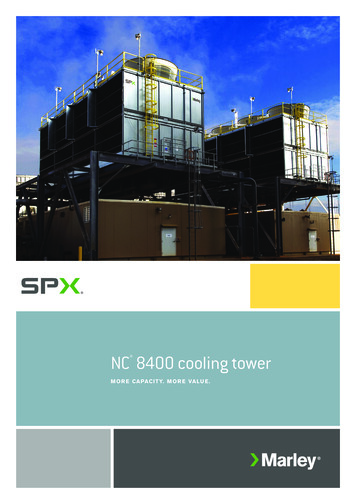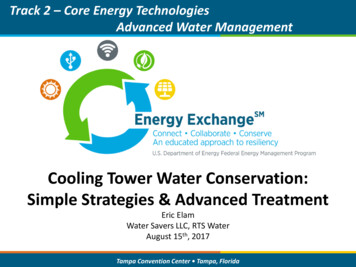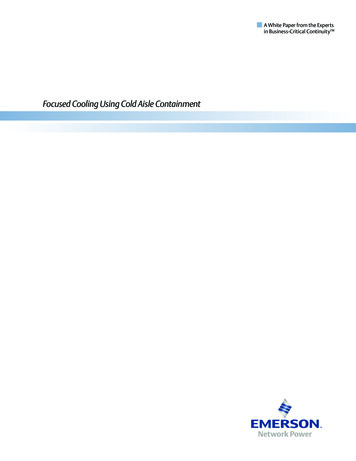
Transcription
A White Paper from the Expertsin Business-Critical ContinuityTMFocused Cooling Using Cold Aisle Containment
Executive SummaryA number of options are available to facilities professionals looking to improve coolingefficiency and reduce resources consumed by their data centers. Beyond implementingbasic measures such as sealing moisture out of the data center and improving air flow,aisle containment to prevent the mixing of hot and cold air stands out as a method thatcan dramatically reduce energy costs, minimize hot spots and improve the carbon footprintof data centers.While either hot aisle or cold aisle containment systems can be installed and are both capableof increasing efficiency and cooling today’s high heat data centers, meaningful differencesexist in how they function and are implemented. This paper reviews both approaches andconcludes that cold aisle containment is the superior solution. Cold aisle containment can beused with or without conventional raised floor cooling. It is easily retrofitted into existing raisedfloor data centers and works in tandem with the raised floor as well as with extreme densitycooling systems to produce highly efficient cooling solutions. By integrating the cold aislecontainment with the cooling system operation, optimal performance and energy efficiencywill be achieved.1
Cold aisle containmentcan be used with orwithout conventionalraised floor cooling.It is easily retrofittedinto existing raisedfloor data centers andworks in tandem withthe raised floor aswell as with extremedensity coolingsystems to producehighly efficient coolingsolutions. A featureIntroductionCooling is the hot topic in data center circlestoday. As heat densities and cooling costs rise,data center professionals are looking for moreefficient cooling solutions. Aisle containmentcan improve cooling performance of a datacenter, assuming it is arranged in a hot aisle/cold aisle configuration. Gartner reports thata 2007 Pacific Gas and Electric study estimatedthat containment could save 20 percent inchiller operating costs. Further, a 2007 studyby Lawrence Berkeley National Laboratoryfound that the electricity used to move thecold supply air could be reduced 75 percent byimplementing cold aisle containment.1and benefit matrixcomparing cold andhot aisle containmentmethods begins onpage 13 .As an addition to a conventional precisioncooling system, cold aisle containmentconsistently separates cold and warmareas without requiring structural changesto the data center. A cold aisle retrofit canbe implemented easily and quickly, carriesa payback time from weeks to a few months depending on whether energy utility rebateswere available to help with funding - and canreduce cooling related energy costs by asmuch as 30 percent, according to Gartner.2be unacceptably high for the serversat the top of the racks and at the end ofthe aisles.The mixing of hot and cold air can beaggravated by a poor balance between thetotal cold air demand to the racks in the aisleand the total supply from the perforated floortiles in the aisle. Increasing the airflow in thecold aisles may help overcome the unbalancedconditions, but doing so will increase energyuse, making it a less efficient solution.Aisle containment works to remedythis situation. Before installing aislecontainment, however, measures shouldbe taken to improve overall cooling systemenergy efficiency.Pick the Low-Hanging FruitThe first step to take is implementing certainbasic measures to increase cooling efficiency,save money and improve your data center’scarbon footprint.Seal the Data Center EnvironmentMinimize the latent (moisture related)cooling load by making sure the data centerhas a good vapor barrier, no leaks arounddoors, windows, etc., and minimal outsideair intake. Sealing out moisture will helpensure that the total available cooling can beused to cool the computer heat load, which is100 percent sensible (no moisture content).Conventional CoolingThe conventional cooling method circulatescold air from computer room precision airconditioning (CRAC) units via a plenum undera raised floor. The CRAC units are locatedoutside the rack rows around the perimeterof the data center.Optimize Air FlowSeveral techniques can help optimize air flowin the data center.Arranging racks into a hot aisle/cold aisleconfiguration (discussed at right) is a coolingbest practice that has been implemented toimprove the efficiency of raised floor datacenters. However, the hot air can diffuse intothe cold air near the top of the racks and onthe end of the cold aisles. The resulting mixedair temperatures can in some casesArrange server racks in a hot aisle/cold aisleconfiguration. Most equipment manufacturedtoday is designed to draw in air through thefront and exhaust it out the rear. This allowsequipment racks to be arranged to create hotaisles and cold aisles. This approach positions2
racks so that rows of racks face each other,with the front of each opposing row of racksdrawing cold air from the same aisle (the coldaisle). Hot air from two rows is exhausted intoa hot aisle, raising the temperature of the airreturning to the CRAC unit and allowing it tooperate more efficiently, as shown in Figure 1.or cannot be removed, they should be underthe hot aisle running parallel with the aisle.Minimize cables in the back of the rack. Usea cable management system in the racksso cables do not obstruct the exhaust airfrom the servers.Install blanking panels in and between theracks. Blanking panels prevent the hot air fromcirculating to the front of the rack where theelectronic equipment air intakes are located.Optimize perforated tile locations. Conductinga thermal assessment of the data center usingcomputational fluid dynamics (CFD) is agood way to optimize the location ofperforated tiles.Place the CRAC units correctly in the room.The CRACs should be located at the end ofthe hot aisles to reduce air travel and preventhot air from being pulled down into the coldaisles as it returns to the air conditioner.Alternatively, use the overhead plenumfor hot air return to the CRACs.Adjust Air Supply TemperaturesIn many data centers it is possible to raisethe air temperature and still remain withinthe ASHRAE recommendations of 64.4degrees F (18 degrees C) to 80.6 degreesF (27 degrees C).3 Raising the temperaturereduces the overall energy requiredfor cooling.Seal the raised floor. Make sure that thereare no leaks at cable penetrations, perimeterpenetrations and raised floor tile joints.Follow Proper Operating GuidelinesMake sure that method of procedures(MOP) and other process documents coveringmaintenance, installation of new equipment,replacements, new cabling, access to roomsMinimize cables and pipes under the raisedfloor. As the saying goes, old cables neverdie. If cables have to be in the raised floorPrecision Air Conditioning Unit(CRAC)[Cold Aisle][Hot Aisle][Hot Aisle][Raised Floor][Perforated Tiles]Figure 1. Hot aisle/cold aisle configuration with raised floor.3CRACs shouldbe located at theend of the hot aislesto reduce air traveland prevent hot airfrom being pulleddown into the coldaisles as it returns tothe air conditioner.
Aisle containmenthas two distinctadvantages. First,it increases thecooling capacity andenergy efficiency ofthe cooling unit andsecond, the increasedand other aspects of routine operation arecurrent regarding energy efficiency, andthat they are followed.One approach utilizes plastic curtains (firecode approved) installed at the ends of theaisle and between the top of the racks andthe ceiling in the room. Plastic curtains canseparate the hot and the cold air, but not asefficiently as solid panels and doors.Implement System MonitoringMonitoring can predict neededpreventive maintenance/actions, suchas filter replacement, which help ensurethe cooling system is operating efficiently.Aisle Containment BenefitsAisle containment has two distinctadvantages. First, it increases the coolingcapacity and energy efficiency of thecooling unit ensuring that the return airtemperature to the cooling unit is high.Second, the increased capacity, together withthe separation of hot and cold air, makes itpossible to cool higher heat loads per rack.capacity, together withthe separation of hotand cold air, makes itpossible to cool higherheat loads per rack.Implement an AisleContainment SystemBeyond implementing these baselinemeasures, a data center can further improveenergy efficiency by separating the hot andcold air streams. Aisle containment, as thissolution is called, is possible once the serverracks have been arranged in the hot aisle/coldaisle configuration.With aisle containment, the aisle is sealed offso the cold air is not mixed with the warm air inthe data center. This is typically accomplishedusing ceiling panels above the aisle betweenadjoining racks and installing doors at theends of the aisle.Pressurized aisles and using plastic curtainsare aisle containment approaches that do notcontain the aisle completely. The pressurizedaisle approach has doors at the ends of theaisle and cooling modules located above oron top of the racks. The modules take hot airfrom the hot aisle, cool it and supply cold airdown into the cold aisle.Additionally, with hotter air returning to thecooling coil, the cooling capacity availablefor cooling the sensible heat generatedby the electronic equipment is increased.Under these conditions the cool supply airtemperature is almost always above the dewpoint. Consequently, there is minimal moistureremoval (latent cooling), which saves energyby allocating more of the total cooling capacityto dissipate the 100 percent sensible electronicheat load. The minimal latent cooling alsoincreases the total energy efficiency becauseof less demand for re-humidification of the air.Two Types of Aisle ContainmentAisle containment can be implemented aseither cold aisle containment (CAC) or hotaisle containment (HAC), configured asshown in Figure 2.Cold Aisle Containment (CAC)ColdAisleRackHot Aisle Containment e ViewHotAisleRackRackHotAisleSide ViewFigure 2. Side view of cold aisle containment and hot aisle containment with raised floor.4Rack
The primary difference between HAC andCAC is that HAC is trying to contain the hot airto make sure that the return air temperatureto the cooling unit is high, while the focus ofCAC is on supplying cold air to the cold aislewhere the equipment air intakes are located.The HAC approach can result in high efficiencyof the cooling unit, but because the cold airdistribution to the servers is open and exposedto disturbances from the room, it has ahigher risk of not providing the server with itsrequired input temperature.Similar to HAC, CAC yields high air temperatureto the cooling unit to increase capacity andefficiency. However, with its focused cooling,CAC supplies the high heat density rackswith cold air with minimal impact from thesurroundings. Therefore, it can enable a higherair temperature leaving the cooling unit, whichincreases the capacity/efficiency of the unitwhile supplying air temperature to the serverswithin the ASHRAE recommendations.Both cold aisle containment and hot aislecontainment can be accomplished in twoprincipally different ways:enable cooling of higher heat loads per rack,but there may be some drawbacks. Thefollowing are the most common objectionsto aisle containment.Potential code issues regarding fireprotection – Contact the local fire authorityto discuss any aisle containment plans tomake sure that codes are followed.Aesthetics and accessibility – Aisle containmentwill challenge the traditional image of a datacenter with open spaces and open access toracks and equipment.Environment for personnel – Because thecontained aisle approach separates the coldand hot air, the temperatures in the roomwill change. Additionally, the sound level canchange. The sound from the servers, and fromthe cooling units inside the containment if theinternal cooling method is used, will be lowerin the room outside the containment becauseof the sound-dampening aisle containment.However, inside the containment space, itwill seem louder because of the containment.Requires hot aisle/cold aisle rack configuration –This entails lining up server racks in alternatingrows with cold-air intakes all facing oneaisle, hot-air exhausts the other. The aislecontainment approach does not work withrear door heat exchangers that cool the rackexhaust air before it enters the room.See also the feature and benefit matrixcomparing cold and hot aisle containmentmethods, for both external and internalapproaches, on page 13.Thermal ride-through – In a traditional datacenter with an open layout/architecture, apower failure to the cooling system will makethe air temperature to the racks rise relativelyslowly because the room air volume can workPotential Drawbacks to Aisle ContainmentAisle containment can save considerablemoney for cooling the data center and also5containment andhot aisle containmentcan be accomplishedin two principallydifferent ways:With the externalcooling method,the cooling unit isExpandability – Racks inside the aislecontainment must be expanded in evennumbers. Additional aisle panels mustbe installed and the door modules mustbe relocated. With the external cooling method,the cooling unit is located outsidethe containment (typically a raisedfloor system with perimeter-locatedCRAC units). With the internal cooling method,the cooling unit is located inside thecontainment (typically above orbetween the racks).Both cold aislelocated outsidethe containmentand with theinternal coolingmethod, the coolingunit is located insidethe containment.
In a data center withaisle containment,the temperature tothe racks will risefaster in case ofa power failurebecause of thesmaller containedair volume.as a thermal storage to ride through shortpower outages. How fast the temperature willrise to a level where the servers start to shutdown depends on many site specific factors:heat load per rack, thermal mass in the roomand size of the room, among others.power failure situation where the coolingsystem, including the air circulating fans, isnot running. In a CAC installation, the exhaustside of a rack is open while the inlet side is aclosed limited air volume; therefore, serverfans will not be able to move air through theservers in the racks. In an HAC installation, theinlet side of a rack is open but the rack exhaustside is a closed limited air volume, resulting inthe same inability of the server fans to moveair through the servers in the racks. The closedlimited air volume is similar for HAC and CAC.In a data center with aisle containment, thetemperature to the racks will rise faster incase of a power failure because of the smallercontained air volume. Full scale tests showthat with no containment in large roomsand low heat densities, the time to servershut down can be 30 minutes or longer;high heat densities in a contained aisleinstallation can give just a few minutesof thermal ride-through time.Computational Fluid Dynamics (CFD)of Air Temperatures With and Without CACFigure 3 below shows the improvements inair temperatures accomplished with cold aislecontainment in a room with high heat densityracks cooled by traditional raised floor cooling.It should be noted that thermal ride throughtime for CAC and HAC will be similar in aAirTemperature90 F (32.2 C)80 F (26.7 C)70 F (21.1 C)60 F (15.6 C)50 F (10 C)Without CACWith CACFigure 3. Computational Fluid Dynamics (CFD) top view (5 feet above the floor) example of airtemperatures in a room with high heat density racks cooled by traditional raised floor cooling,shows isolated, uniform cooling in the cold aisles with CAC compared to without CAC. Averagereturn air temperature to the CRACs without CAC is 75 degrees F (23.9 degrees C) and with CACit is 85 degrees F (29.4 degrees C). The room with CAC requires two fewer CRAC units.6
Cold Aisle vs. Hot Aisle ContainmentAs mentioned previously, both containmentmethods will address high heat densities andimprove cooling efficiency. However, they bearsignificant functional differences that shouldbe kept in mind when selecting a containmentsolution for the data center.Hot Aisle Containment with External Cooling(Cooling unit outside the containment,typically raised floor application)Creates additional cooling load – Using a ceilingplenum and additional return air ducts givesadditional pressure drop in the air circulationthat needs to be handled by larger fans thatconsume more power and add cooling loadto the room.Limits ability to retrofit – HAC can be difficultto install as a retrofit, especially withoutinterrupting data center operation, becauseof the additional required ducting.Inefficiency of chimney rack – One version ofhot aisle containment is called the chimneyrack. This is a rack with a separate rearchimney for the hot air exhaust. The chimneyis connected to a hot air return plenum/ducting in the ceiling. Typically this approachlimits flexibility, uses extra overhead spaceand also requires exhaust fans at each rack.These fans consume significant energy andadd cooling load to the room. Also, the airflow can only work properly if the servers aresealed in place. If a server or blanking panel isremoved for service, the chimney flow can beinterrupted causing hot air to escape back intothe cold side of the rack.Hot aisle containment offers efficiencyimprovements compared to traditionalnon-contained cooling approaches, but italso exhibits some limitations:Cooling is not focused cooling – In HAC, thecold air distribution from the cooling unit thatexhausts to the server rack inlet is “open” anddependent on surrounding area conditionsand equipment. The open air distributionincreases the risk of providing the servers withinput air that is not the required temperature.Air temperatures potentially are high – Becauseof the containment of the hot aisle, whichlimits the mixing/leaking of cold air intothe hot aisle, air temperatures can exceedacceptable levels for personnel working inthe aisle.Hot Aisle Containment with Internal Cooling(Cooling unit inside the containment)From an efficiency perspective, HAC withinternal cooling can be more advantageousthan with external cooling. However, severallimitations still exist:Requires complete hot air ducting – For HACto work correctly and avoid mixing hot andcold air, the hot return air must be ducted allthe way from the HAC to the air inlet of theCRAC.This typically entails using the overheadplenum for return air (if possible), ductingbetween the HAC and ceiling plenum, andducting between the ceiling plenum andthe CRACs.Cooling is not focused cooling – As with HACwith external cooling, in HAC with internalcooling, the cold air distribution from thecooling unit that exhausts to the server rackinlet is “open” and dependent on surroundingarea conditions and equipment. The open airdistribution increases the risk of providingthe servers with input air that is not therequired temperature.Requires overhead space – Overhead space isneeded for the hot return air plenum/ducts.7Both cold aisle andhot aisle containmentmethods will addresshigh heat densitiesand improve coolingefficiency. However,they bear significantfunctional differencesthat should be kept inmind when selecting acontainment solutionfor the data center.
Cold aisle containmentwith external coolingis typically deployedin a traditional raisedfloor environmentwith perimeterlocated coolingunits, as shownin Figure 4.Air temperatures potentially are high – Becauseof the containment of the hot aisle, whichlimits the mixing/leaking of cold air intothe hot aisle, air temperatures can exceedacceptable levels for personnel working inthe aisle.Takes up floor space – Cooling units aretypically floor mounted between the racksin the middle of the data center, taking uppremium floor space.The CAC approach encloses the cold aislewith ceiling panels above the aisle betweenadjoining racks and with doors at the end ofthe aisle, so the cold air from the perforatedfloor tiles in front of the cabinets is containedand delivered to the electronic equipmentair inlets. The CAC prevents cold air frommixing with warm air or being obstructedby surrounding equipment/sources before itreaches the servers. Because CAC possessesthis ability, it is called focused cooling.Does not work in conjunction with raisedfloor cooling – Can be used in a raised floorinstallation but typically not in conjunctionwith raised floor cooling. In a room with bothraised floor cooling and HAC, the raised floorcooling should not be expected to providecooling for the racks included in the HACsystem unless the HAC, in addition to theinternal cooling, also has complete hot airducting all the way to the air inlet ofthe CRAC.Requires piping for chilled water orDX-based cooling – Each cooling unitrequires pipes/connections for chilledwater or direct expansion applications.The data center needs humidity controland, if dehumidification (latent cooling)and humidification are provided in therow-located cooling unit, both water drainand water supply piping are required in theheart of the data center. Without a raisedfloor, the water piping for the cooling unitsinside the HAC typically must be installedabove the electronic equipment.Figure 4. Cold aisle containment deployed in atraditional raised floor environment.Cold aisle containment with external coolingcan typically cool 10 to 15kW heat load perrack. However, maximum capacity dependson site specific factors such as raised floorheight, rack layout and others.In addition to its ability to cool high heatdensities, the focused CAC approach also:Increases cooling capacity and efficiency –Minimizes cold and hot air mixing so thereturn temperature to the cooling unit ishigher. This enables increased cooling unitcapacity, as shown in Figure 5, and increasedefficiency, as shown in Figure 6. Also,because of the focused cooling approach,CAC can enable a higher air temperatureleaving the cooling unit (and still supplyair temperature to the servers within theCold Aisle Containment with External Cooling(Cooling unit outside the containment,typically raised floor application)Cold aisle containment with external coolingis typically deployed in a traditional raisedfloor environment with perimeter locatedcooling units, as shown in Figure 4.8
ASHRAE recommendations), which will furtherincrease the sensible capacity/efficiency of theunit. In order to achieve optimal efficiency, theCAC can be done with air flow control of theCRAC units based on the server needs.installation only entails adding cover panelsabove the aisles and doors at the end of theaisles. Typically this can be accomplishedquickly without a shutdown. Spacerequirements for CAC are almost negligible.Retrofits easily – Unlike hot aisle containment,CAC is easy to install in an existing datacenter. Adding CAC to an existing raised floorUses the existing raised floor coolinginfrastructure – Most data centers are usingraised floor cooling and CAC can extendChilled Water CRACSensible Capacity Increase (%)80Direct Expansion CRAC70605040302010070 F21.1 C75 F23.9 C80 F85 F90 F26.7 C29.4 C32.2 CReturn Air Temperature95 F35.0 C100 F37.8 CFigure 5. Typical CRAC cooling capacity increase (normalized at 75 degrees F (23.9 degrees C))at different return air temperatures. (Fixed CW flow rate for the CW CRAC)Chilled Water CRAC80Direct Expansion CRACEfficiency Increase (%)70605040302010070 F21.1 C75 F23.9 C80 F85 F90 F26.7 C29.4 C32.2 CReturn Air Temperature95 F35.0 C100 F37.8 CFigure 6. Typical CRAC cooling efficiency increase (normalized at 75 degrees F (23.9 degrees C))at different return air temperatures. (Chiller and CW pumping not included for the CW CRAC)9
containmentwith internalcooling can coolmore than30kW heatload per rack.Increased cooling capacity and efficiency –Mixing of cold and hot air is minimized sothe return temperature to the cooling unit ishigher. In addition, the location of the coolingunit close to the heat source gives a higherreturn air temperature to the coil, comparedto when the cooling unit is located outsidethe containment. This further increasesthe cooling unit capacity (see Figure 7) andefficiency (see Figure 8). In addition, becausethe cooling unit is in close proximity to theheat generating racks, much less energyis required for air movement comparedto cooling approaches with the coolingunit located outside the containment. Thesavings in energy required for air movementis typically at least 75 percent and, fora complete system, at least 25 percent,compared to conventional perimeter cooling.the raised floor performance with onlya minor investment.Cold Aisle Containment with Internal Cooling(Cooling unit inside the containment,typically above or between the racks)Cold aisle containment with internal coolingcan be deployed in a traditional raised floorenvironment or on a slab. Similar to CAC withexternal cooling, CAC with internal cooling hasa focused cooling approach and contains thecold air by enclosing the cold aisle using topceiling panels and doors at the end of the aisle.However, with internal cooling, the cold air isdelivered to the contained aisle from coolingunits located inside the containment, above orbetween the racks. The cooling units take thehot air directly from the hot aisle, cool it anddeliver it to the cold aisle. In order to achieveoptimal efficiency, the CAC can be done withair flow control of the internal cooling unitsbased on the server needs.Also, because of the focused coolingapproach, CAC can enable a higher airtemperature leaving the cooling unit (and stillsupply air temperature to the servers withinthe ASHRAE recommended guidelines), whichwill further increase the capacity/efficiency ofthe unit.Cold aisle containment with internal coolingcan cool more than 30kW heat load per rack.Additional advantages with the focused CACapproach include:40Liebert XDO20Liebert XDV10Liebert XDH20Liebert XDH323530Sensible Capacity (kW)Cold aisle252015105080 F26.7 C85 F29.4 C90 F32.2 C95 F100 F35.0 C37.8 CReturn Air Temperature105 F40.5 CFigure 7. Cooling unit capacity at different return air temperatures (at 60Hz).10110 F43.3 C
The Liebert XDV top cooling modulemounts vertically on or above the IT rackenclosure, requiring no floor space. Itdraws hot air from inside the cabinet orfrom the hot aisle. It then cools the airand discharges it down to the cold aisle. The Liebert XDH in-the-row coolingmodule is placed directly in line with therack enclosures, and requires very littlefloor space. Air from the hot aisle is drawnin through the rear of the unit, cooled,and then discharged horizontally throughthe front of the unit into the cold aisle.Can be used with a raised floor – Unlike HAC,the CAC can be used in conjunction withraised floor cooling. The CAC with internalcooling works in tandem with raised floorcooling to provide the contained cold aislewith cold air, as illustrated in Figure 9.Available with top mounted non-water basedcooling units, Liebert XDV or Liebert XDO, so nofloor space in the middle of the data center isused for cooling equipment, or with high capacitynon-water based floor mounted cooling unit,Liebert XDH – Liebert XD pumped refrigerantbased cooling provides focused, efficientand flexible high heat density cooling. Thepumped refrigerant is ideal for use aroundelectronic equipment. It operates at lowpressure in the piping circuit and if a leakwere to occur, the environmentally friendlyrefrigerant would escape as a gas, causing noharm to critical equipment.Efficiency Ratio, SCOP4, Unit Fans Only(kW out/kW in) The Liebert XDO overhead coolingmodule mounts directly above thecold aisle, requiring no floor space.It draws in hot air from the hot aisle,then discharges cool air into the coldaisle where the equipment air inletsare located.70Liebert XDO20Figure 9. Cold aisle containment with LiebertXDV units mounted on top of the racks andraised floor cooling working in tandem.Liebert XDV10Liebert XDH20Liebert XDH32605040302010080 F26.7 C85 F29.4 C90 F32.2 C95 F35.0 C100 F37.8 C105 F40.5 CReturn Air TemperatureFigure 8. Cooling unit efficiency ratio at different return air temperatures (at 60Hz).11110 F43.3 CUnlike HAC,the CAC can be usedin conjunction withraised floor cooling.The CAC with internalcooling works intandem with raisedfloor cooling to providethe contained coldaisle with cold air, asillustrated in Figure 9.
ConclusionReferencesWhile hot aisle and cold aisle containmentsystems both are capable of increasingefficiency and cooling today’s high heatdata centers, cold aisle containment betteraddresses the task of separating hot and coldair while supplying cold air to the servers.Cold aisle containment has a focused coolingapproach and can be used with or withoutconventional raised floor cooling. It is easilyretrofitted into existing raised floor datacenters, can be done with air flow controlof the cooling units based on the serverneeds and will create highly efficient coolingsolutions when used in tandem with raisedfloor and/or extreme density cooling systems.1., 2. Gartner, 2008. McGuckin, Paul. CoolMore With Less in Your Data Center.3. 2008 ASHRAE Environmental Guidelinesfor Datacom Equipment - Expanding theRecommended Environmental Envelope.4. ANSI/ASHRAE Standard 127-2007Method of Testing for RatingComputer and Data ProcessingRoom Unitary Air Conditioners.12
Feature/Benefit MatrixHot Aisle ContainmentFeatureBenefitFocusedcoolingLess exposureof cold airdelivery to thesurroundingsincreasesavailabilityand efficiencyLow complexityof coolingredundancyLowerinitial costEnergyefficiencyLoweroperating costsAbility toretrofit inraised floorinstallationsIncreasedflexibilityin retrofitscenariosCapability tocool high heatdensitiesAllows racksto be filledwith highheat emittingequipmentFairGoodCold Aisle ContainmentExternalCoolingInternalCoolingExternalC
Cooling is the hot topic in data center circles today. As heat densities and cooling costs rise, data center professionals are looking for more efficient cooling solutions. Aisle containment can improve cooling performance of a data center, assuming it is arranged in a hot aisle/ cold aisle configuration. Gartner reports that

